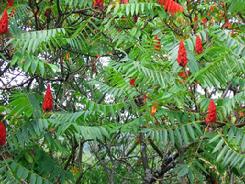
|
 |
 |
|
Plants of Whitetail Wetlands:
Plants are more than a backdrop for a wetlands, more than pretty flowers, they are more than a place for animals to live and hide, more than a source of food. They are the basis for a wetlands: as the water is filtered through the various bodies, the marshes and impoundments, it's the plants that keep soil from being washed away. Even with their death they aid the process by replenishing the soil. Without these plants, there would be no wetlands. A wetlands can be a botanist's dream, with many different types of plants thriving and interacting within a micro environment.
|
 |
| Broad-leafed Arrowhead plants, with their white flowers, proliforate along pond edges providing shade in shallow areas where minnows hide. |
|
|
 |
| Canna lillies are very important to the butterfly and hummingbird populations. We will have approx. 250 of them this year. |
|
|
 |
| Closed Gentian |
|
|
|
 |
| Joe Pye Weed |
|
|
 |
| The thistle is one of the most important "weeds" in the wetlands. It provides nectar food for butterflies, shelter for tiny eggs, and seed food for finches. |
|
|
 |
| Asters |
|
|
 |
| Skunk Cabbage |
|
|
 |
| Sumac |
|
|
 |
| Pokeweed |
|
|
 |
| Ironweed |
|
|
 |
| Swamp Milkweed |
|
|
|
|
|
 |
 |
|
 |



